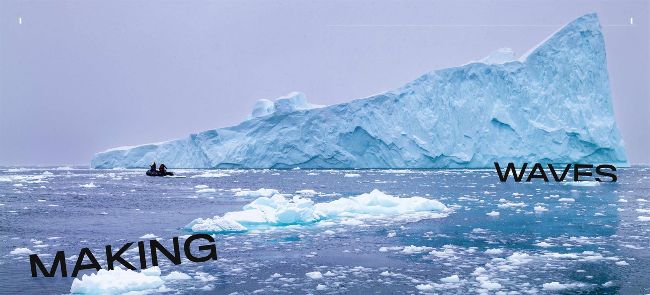WHALE CONSERVATION
MAKING WAVES
How do you study a gigantic mammal that migrates over thousands of miles and spends most of its time underwater? Here’s how the latest tech is shaping the future of whale conservation
by JAMES FAIR

Scientists in a small inflatable boat floating in the vast, freezing expanse of the Antarctic, hope to spot a whale to tag, film and study
COPYRIGHT © TED GRAMBEAU 2023 INTREPID TRAVEL / UCSC / WWF. IMAGERY COLLECTED UNDER SCIENTIFIC PERMITS: NMFS #23095, ACA # 021-006.
On a calm, cold afternoon in early March, in Neko Harbour on the west coast of the Antarctic Peninsula, a humpback whale is making a series of moves that – to me, at the time – have no obvious purpose.
First, the humpback raises one of its outsized pectoral fins – which can reach up to 5m in length, longer than a typical estate car – as if asking for permission to speak in class, before diving and resurfacing. Then it raises the fin again, carrying on like this for another 15 minutes.
Chris Johnson, oceans science manager for WWF-Australia, is watching from a nearby boat and releases a drone equipped with a video camera. The footage transforms what appears from sea level to be a set of random exercises into a stunning performance as choreographed as any ballet.
As it turns out, the pectoral fin is being used as a rudder to steer the humpback in a tight circle while it blows a ring of bubbles. Once that’s done, it dives down and then surges up through the middle of the ring, engulfing the bounty corralled by the bubbles in its cavernous mouth. The whale is bubble-net feeding for krill, its primary food source in Antarctica.
Dr Ari Friedlaender, professor of ocean sciences at the University of California, Santa Cruz, is also aboard the boat and has seen this behaviour many times before. Nevertheless, the perspective provided by the drone offers exciting new insights. “I knew it was making bubble-nets but what I couldn’t tell without the help of the drone was how small and tight that net was,” he tells me later. “That bubble net was smaller than the whale was long purely because it could pivot around its flipper and you can see that in the video quite clearly.”
HERE FOR THE FOOD
Whales – including humpbacks, blue, fin, sei and Antarctic minke – migrate south for the Antarctic spring and summer to take advantage of the fecundity of krill that lives there, the largest biomass of any marine species on the planet. They come because the waters of the tropics, where they mate and give birth, are too warm to produce the vast amounts of krill the whales need (the crustaceans not only prefer colder waters but also rely on the algae that grows beneath the ice sheets for food).